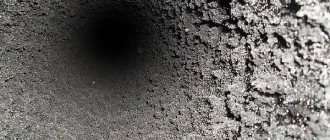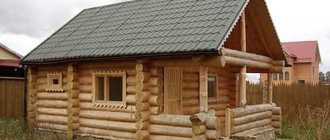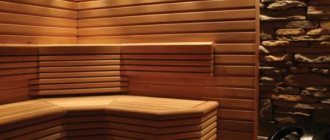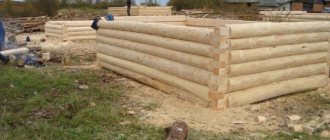Created: 06 Nov 2018
Press onto the stones by hand.
Succumb to the stones. Not by hand.
Use a bowl or water tank.
Evaporator, also known as steam generator. Built-in.
Arrangement of the finished steam room with equipment.
The increase in humidity in the sauna is due to water. During heating, the water begins to evaporate, due to which the “Russian bathhouse effect” occurs. Remember going to the bathroom: after you take a shower, the mirror fogs up. The same thing happens in the kitchen when you cook something. Mechanical hood can compensate for this phenomenon, but you get the point. If you turn on only cold water in the shower, the mirror will not fog up. Using these simple everyday examples, everyone can see in their own home that hot water creates humidity. In a sauna, if there is no water in any form, the heater will only dry the air, because in this case it will act as a heating device that increases the temperature. To create humidity in a steam room, you just need to allow the water to heat up and evaporate. There are many options for this. Let's consider everything.
Peculiarities
Ventilation in a bathhouse can be done in various ways.
Its presence depends on:
- distribution of heat flows inside;
- comfort and safety of washables;
- period of operation of the building.
Water and steam are continuously concentrated there, and the tree actively absorbs them. Even if you dry the building periodically, without establishing constant air movement, the effect will not be strong enough. To prevent dampness, it is necessary to create a pair of ventilation windows - one serves to bring in clean air from outside, and the other helps the heated air, which has absorbed a lot of water, to escape. When selecting the location of the openings, change areas that are particularly intensively ventilated. The use of a pair of outlet openings in the steam room and dressing room sometimes improves the orientation of the air flow in the required direction.
Of course, the size of each window and the ability to adjust the clearance are of great importance. They are equipped with valves that can be opened fully or partially. The calculation of the volume of ventilation holes is based, first of all, on the area of the bathhouse premises. If you make them too large, mold will never appear on the floor and in the sink, but the steam room will take a very long time to heat up, and an unusually large amount of fuel or electrical energy will be consumed. Windows that are too narrow will not allow the air inside to cool or become drier.
All deviations from normal parameters are strictly unacceptable, which eliminate the occurrence of powerful temperature changes - this not only creates discomfort, but can also provoke health problems. It is impossible to completely eliminate differences in the temperature of the flows; it is only necessary to limit their magnitude. Normal ventilation systems are formed during the construction of the bathhouse, while channels are made and openings are prepared. Windows are installed only after the decorative cladding of the building has been completed. Therefore, you will have to enter information about the design of ventilation ducts into the bathhouse design.
In most cases, ventilation openings are made strictly the same. The outlet hole can be made larger than the inlet hole, but according to safety rules it cannot be smaller than the first one. For the same reasons, they sometimes resort to paired exit windows. It is worth using valves rather than doors as control elements; when closed, it is impossible to maintain the gaps. When the steam room warms up for the first time, the valves are closed 100% until the air reaches the desired temperature.
The use of elements with controlled position is also useful because the amount of air flow must be adjusted according to the season. When there are negative temperatures outside, even a very small trickle of air brings a lot of cold. Therefore, you should not open the ventilation windows completely. The cross sections of such windows should average 24 square meters. cm per 1 cu. m of internal volume. But these are only preliminary figures, and if you doubt the result obtained, you should contact qualified heating engineers for calculations.
It is strictly forbidden to place ventilation windows at the same height or even directly opposite each other, since this will not allow all the air in the bath to be warmed up sufficiently. In addition, such a design will not allow air masses to mix evenly, which means that it will be necessary to carefully calculate the accuracy of the location of the ventilation elements. It is recommended to place exhaust windows just below the ceiling, because the air immediately rushes upward after heating.
How to take a steam bath in a Russian sauna without mistakes
The best option would be not to let the organization of steam in a Russian bath take its course, but to properly heat the bathhouse and steam yourself or with a group, while the real light steam of a Russian bath is in the steam room. Visiting the steam room several times is also quite possible, but before each time the procedure for equalizing the humidity and temperature will have to be repeated anew. How quickly the steam in the steam room will be “corrected” for a new session depends on its design and proper management of the heater and vent.
After entering the steam room, after 20-30 minutes, the body adapts to the temperature and humidity, and a feeling of cooling of the steam room will appear. With good thermal insulation of the walls and a high-quality stone stove, good steam will last for an hour or two. In a bathhouse with a steel potbelly stove, real steam from a Russian steam room will last no more than half an hour.
Common Mistakes
A typical error in steam management is flooding the heater with excess water. In this case, something like a Turkish hammam is formed in the Russian bathhouse for a short time. After another ten minutes, the steam room will begin to cool quickly, and due to the high humidity, dampness and discomfort will appear. It’s even worse if you heat the heater white-hot, add water to the heater, and fill the steam room with a hot, humid cloud that makes it impossible to breathe.
In the first case, you should leave the steam room, correct the operation of the stove and remove the water from the heater. After adding a new portion and heating the oven, as the steam room warms up again, it is recommended to open the valve and remove most of the steam with cooled air from the steam room. Having thoroughly added heat to the atmosphere of the steam room, they enter the room and in small portions increase the water content in the air of the room.
Sometimes the work of pouring hot water onto the stones is replaced with an aluminum flask holding a couple of liters of water, from which water drips through the unscrewed cap onto the hot stones of the stove.
Advice! Particularly effective will be the combination of watering the stones with water and fanning the hot heater with a towel or piece of plywood. Some masters are able to organize real light steam, typical of a Russian bath, in 10-15 minutes.
In the second case, it is better to ventilate part of the humid and boiling atmosphere from the steam room. The temperature in the Russian bath will drop and the humidity will level out. You can open the doors to the dressing room and wait until the dry air from the bathhouse premises expels the hot cloud into the ventilation.
The secret of easy steam
One of the most popular options is the combination of a sauna and a Russian bath in one steam room. Not everyone likes this method of steaming, but in many cases it is suitable if people in a group like different temperature conditions.
The essence of the method is as follows. First, the steam room is heated to the highest possible temperature and low humidity. Those who love the Finnish “brazier” can steam in such a sauna. During this time, the bulk of the stone in the stove warms up to the maximum, then you need to open the ventilation of the steam room while simultaneously adding humidity by watering the heater with small portions of hot water.
Many people like to visit the steam room. But in order to relax, get a positive result from the procedure, and at the same time not harm your health, you need to know what the optimal temperature in the bathhouse is. It is also necessary to take into account the degree of air humidity and the quality of steam.
Succumb to the stones. Not by hand.
An auto-dosing device or a simple dispenser will do the necessary work almost without your participation. Just press a button or add water.
The device connects to the water supply and can be mixed with flavors.
Water and flavoring are added to a simple dispenser, which are then dripped onto the stones from a bowl suspended above the stove.
Modernization
Only in the 20th century did the construction of saunas with stoves equipped with chimneys begin. And in the 30s, saunas and steam rooms appeared with a metal partition that separated the flames and stones. The temperature remained high for as long as possible. A huge advantage of this type was the absence of soot. In the 50s, saunas with separate changing rooms began to be built, and as development progressed, the steam room area began to be separated. The next stage of development was the emergence of electric ovens, which turned out to be easy to use and safe. Since this option does not require a chimney, this type of stove can be installed almost anywhere.
Use a bowl or water tank.
Models of heaters with a built-in tank are available for sale. For wood-burning heaters, the tank can be located on the side or in the front. It has a tap for draining water.
|
The water tank can also be installed on the chimney.
Electric heaters can be sold with a water compartment built into the stones.
There is also a solution for ready-made saunas: an evaporator that is inserted into the stones. This flask will fit any heater. You just have to remove a few stones to build it in.
Arrangement of ventilation and thermal insulation
The level of heat and its preservation depend on how well the thermal insulation is done and how the bathhouse is built. To keep the heat longer, a heat insulator is placed between the walls during construction. Only then can the optimal temperature for a Russian bath be maintained.
Ventilation in the sauna is needed to maintain equal pressure inside and outside. As for the Russian version of the bathhouse, the air pressure in it is increased, so steam must be supplied carefully so that the doors do not blow out. A bathhouse with high humidity leaves condensation on all surfaces, so dry cleaning and long-term ventilation are required after visiting.
The bathhouse is a real panacea for diseases. Bath procedures help improve blood circulation, thereby accelerating metabolic processes. But for comfort in the bathhouse you need an appropriate microclimate. The optimal temperature/humidity ratio is 60/60. At the same time, higher temperatures and humidity cause significant discomfort. And the lack of humidity makes the vaping procedure unpleasant. Therefore, many lovers of Russian baths are wondering how to increase the humidity in it.
How to make your stay in the steam room comfortable
A Russian bath requires knowledge and the ability to steam: in order for the steam in the bath to be “light”, you need to be a master of the bath business
There can be many reasons for the lack of humidity in the steam room. The most common of them is the incorrect selection of the stove.
Modern stoves are designed for baths or saunas. The second option involves dry heat at high temperatures. As professionals say, if you increase the humidity in a hot bath (at a temperature above 70°C), you can simply cook it. If you have a problem with the stove, then it is more advisable to change it.
Some people advise placing a brick screen around the stove, which will partially absorb the heat. In this case, to achieve the desired level of humidity, you will have to pour a large amount of water onto the heater.
The ideal ratio of temperature and humidity in a Russian steam room is obtained when the heat-intensive heater is made of brick.
Another reason is the dry wood of the walls and ceiling.
Dry wood quickly absorbs moisture. To prevent this from happening, pour water over the walls and ceiling while heating the steam room. While the stove is heating, the wood will absorb some of the water, and the rest will evaporate, increasing the humidity.
A leaking water tank attached to the stove will significantly increase the humidity. The water in the tank will heat up and evaporate. The amount of steam depends on the area of the open hole in the tank - the larger it is, the stronger the evaporation.
You can place a metal basin with water on the shelves in the steam room, which will evaporate during the steaming process.
Finally, before taking bath procedures, you can install an air humidifier or steam generator in the steam room.
This is how professionals advise increasing the air humidity in the steam room to the desired level.
The best way to spend time for your body and peace of mind in winter is in the steam room. But which one should you choose? How to set the temperature there correctly to really improve your health?
Temperature and humidity
The bathhouse consists of three zones: a locker room, a dressing room and a steam room. In the first of them, the temperature is about 25 degrees and the humidity is 60%, in the dressing room it is 27-29 degrees and 80%, respectively. The temperature in the steam room of a Russian bath is 50-90 degrees, humidity is approximately 70%. The degrees increase gradually and the body has time to get used to the heat. The water in the reservoir should be cool, in the range of 10-25 degrees, so that the contrast with the steam can be felt.
A study was conducted to find out what temperature and how long the body can withstand.
According to it, they came to the conclusion that the higher the temperature, the less time the visitor can be present in the steam room:
- 71 degrees – 60 minutes;
- 82 degrees – 49 minutes;
- 93 degrees – 33 minutes;
- 104 degrees – 26 minutes.
In the sauna and bathhouse, it is imperative to monitor the temperature and air humidity. For this purpose, appropriate devices are installed in the room. If there is not enough humidity, you can pour water on the stones; when there is a lot of it, open the door slightly. When it gets hot, it is recommended to sit further from the stove and, preferably, on the lower shelf.
When does the need to reduce it arise?
If the stove is incorrectly selected or installed, the temperature in the steam room is disrupted. When the temperature changes above the specified norm in a Russian bath, the steam becomes “heavy” and intense heat is felt. This happens if the power of the stove does not correspond to the volume of the steam room. When operating metal stoves with a tank, complaints sometimes arise about increased humidity at low temperatures in the steam room (40-45 degrees). The water boils early, when the bath has not yet warmed up.
Therefore, even at the design stage it is necessary to select a suitable furnace. An increase in humidity in the bathhouse is possible due to inadequate air exchange.
Ventilation in the log bathhouse was not specially thought out, since the humidity outside and in the steam room was approximately the same. The issue was resolved by the construction itself
Now there are various modifications to the construction of baths, and special attention should be paid to ventilation planning. If the bathhouse has already been built, sometimes it is necessary to install a forced fan to eliminate this problem
There is a method that allows you to reduce the accumulation of condensation on the ceiling and walls in the bathhouse (and, as a result, increase their service life), as well as ensure the creation of an adequate steam pocket.
Hot air collects under the ceiling and settles on it. The tree initially absorbs moisture, and then stops, and a so-called steam pocket is created. To adequately create steam, the ceiling must have a heat capacity.
To do this, at the construction stage of the bathhouse, the following structure should be formed.
When the walls have already been erected, reflective heat-insulating material - penofol - is sewn onto them and onto the ceiling using a construction stapler. It is applied in a specific way: one edge overlaps the other to create a continuous layer. Then wide bars are nailed to which the eurolining will be attached. As a result, an air gap is created between the inner and outer cladding of the walls and ceiling.
The furnace vent is mounted below floor level, and concrete is poured with a slope towards the drain pipe. The logs are installed in the form of a platform, waterproofing material is laid under them, and floorboards are laid on top. An air gap also forms under the top layer of the floor.
How does this design work?
Hot steam passes from the room through the eurolining and is retained between it and the foam foam layer, creating a steam pocket. When condensation forms due to temperature changes, it flows onto the floor along the foil. The ash door opens and moist air exits through the chimney.
So, high humidity in the bathhouse will be comfortable if, at the design stage, you choose the right model and size of the stove and think about ventilation. In order for the sauna to last longer and to create the correct steam pocket, you need to create air gaps in the ceiling, walls and floor.
Arrangement of ventilation and thermal insulation
The level of heat and its preservation depend on how well the thermal insulation is done and how the bathhouse is built. To keep the heat longer, a heat insulator is placed between the walls during construction. Only then can the optimal temperature for a Russian bath be maintained.
The steam room must be built in such a way that heat cannot escape. For this purpose, the doors are made low and the thresholds high. It is better to place the stove near the door, then the steam room will warm up evenly. To keep the floor surface warm, the floor covering is laid in several layers.
Ventilation in the sauna is needed to maintain equal pressure inside and outside. As for the Russian version of the bathhouse, the air pressure in it is increased, so steam must be supplied carefully so that the doors do not blow out. A bathhouse with high humidity leaves condensation on all surfaces, so dry cleaning and long-term ventilation are required after visiting.
The level of heat and its preservation depend on how well the thermal insulation is done and how the bathhouse is built. To keep the heat longer, a heat insulator is placed between the walls during construction. Only then can the optimal temperature for a Russian bath be maintained.
What to do to remove dampness in a bathhouse?
| After each use of the bath/sauna, open all kinds of dampers for ventilation. In the winter season, this is not entirely effective, since drying takes much longer than in warm weather. |
| Use an exhaust fan and adjust the humidity level to the desired hygrometer reading. Regularly clean the ventilation ducts and treat them with antiseptic agents. |
| Use air dryers. Stationary and mobile dehumidifiers turn on at any time after using the bath. The settings on the device panel allow you not to control the level of humidity in the room; the dehumidifier will do this for you. All condensate ends up in a special container or it can be removed using a hose into the sewer. |
Meaning
Visiting saunas brings not only pleasure, but also significant benefits for the body as a whole. Regardless of the type, there are a number of undeniable advantages:
Sauna – what is it and what tips should not be ignored? An important task is to follow precautions and certain rules. The length of time you spend in the steam room depends on personal preference and health status. But the first run should be limited to 5 minutes, provided that the temperature is 70°C
But the first run should be limited to 5 minutes, provided that the temperature is 70°C
The length of time you spend in the steam room depends on personal preference and health status. But the first run should be limited to 5 minutes, provided that the temperature is 70°C.
The second session after rest and if you feel stable can increase to 10 minutes.
It is important to remember that it is not recommended to get dressed immediately after visiting the steam room. The body needs to rest for some time.
What should be the temperature and humidity in the bathhouse during health procedures? This question is no less important than the choice of a heater or a bath broom.
First of all, novice bathhouse attendants need to know this, because it is difficult for them to determine the correct ratio of these parameters when visiting the steam room for the first time.
The most popular steam rooms are the Russian bath, Finnish sauna and Turkish hammam. They gain particular popularity and trust.
What temperature should be in a bathhouse, sauna or hammam for safe cleansing procedures?
- In a Russian steam room, maximum heating is carried out at 65–90°C, humidification at 55–90%;
- In a Finnish sauna, heating is provided at 72–110°C, humidification is up to 5–16%;
- In a Turkish hammam, heating is provided at 45–50°C, humidification at 85–100%;
- In an infrared sauna, heating is provided at 35–45°C, humidification at 45–60%.
It is important to understand that the optimal temperature for warming up and humidifying the air is acceptable for all categories of visitors. However, beginners prefer gentle procedures, while experienced bathhouse attendants prefer hotter ones
The effect of heat on the human body
As blood circulation accelerates, pressure rises. The bath is useful for people who suffer from blood stagnation in the extremities. However, for those who have problems with the heart and blood vessels, the steam room can be harmful.
But some diseases can, if not get rid of, then significantly alleviate their course, provided that you regularly take procedures in the steam room.
These include:
- frequent colds;
- obesity;
- allergy;
- circulatory disorders.
How to visit the bathhouse
Having found out what temperature should be in the steam room of the bath, you need to pay attention to how to properly attend the procedures. First of all, this needs to be done regularly, not occasionally.
- A person visiting the steam room for the first time should not stay in it for more than 5 minutes. There is no need to use brooms right away. When no problems arose during the first visit, gradually, each time, the time of stay can be increased by a couple of minutes.
- Those who often visit the bathhouse know that it is highly undesirable to stay in the steam room for more than half an hour. But this does not mean that you need to sit until the end - if you feel uncomfortable, you should leave it.
- You should not stand in the bathhouse, as you can get heatstroke. The position of the body should be such that favorable conditions are created for the outflow of lymph - you need to lie with your legs elevated. Thanks to this, the load on the heart is reduced. If it is impossible to lie down, it is recommended to sit so that your legs are at the level of your torso.
- To warm up the body, you should change postures. You only need to breathe through your nose.
- There is no need to stand up suddenly, as you may lose your balance and fall.
- Regardless of the temperature of the Russian bath, you are allowed to enter the steam room 3-4 times. Moreover, after each visit, the time spent in it or the locker room should increase.
- Between visits to the steam room, contrasting procedures are needed. It is better to start tapping with brooms after the second visit to the steam room.
- When the body warms up, you can do a massage. But before this, it is not advisable to go into other rooms or drink cold drinks. After completing the massage, take a warm shower and wash.
- The visit to the bathhouse ends after the body has dried and cooled down - there is no need to immediately go outside.
Besides:
visit the steam room at least 1.5 hours after eating; no need to steam at high temperatures or when you feel unwell; no smoking; You should remove metal objects from yourself to avoid burns; no need to wash your hair in the steam room; you need to remain calm and not make sudden movements; you cannot go to the bathhouse on an empty stomach and drink alcohol; Before going outside, you should cool down and rest; You should use a broom only on a steamed body; You need to wash only after the steam room; when visiting the steam room, do not immediately lie down on the top shelf; You don't need to create a lot of steam on your first run.
You need to take bath accessories with you:
- sheet and towel;
- soap and shampoo;
- brooms;
- head cap and slippers;
- robe;
- comb
- drinking water.
First visits
If you are going to visit the steam room, then you should do it regularly, and not from time to time. The human body benefits from constant procedures that promote sweating. For beginners, there are several rules that will help make bath procedures comfortable.
You need to prepare properly for the bath
- A person who comes to the bathhouse for the first time is not recommended to stay in the steam room for more than 5 minutes. There is no need to use brooms right away. If the first visit went without problems, the next time the time spent in the steam room can be gradually increased by 1-2 minutes.
- Fans of bath procedures know that you need to steam for no more than 30-35 minutes at a time. But the procedure is not determined by time: if a person feels unwell, he needs to leave the steam room.
- It is not recommended to stand in a Russian bath or sauna: you can get heatstroke. The position should be such that it promotes the outflow of lymph, that is, it is better to lie with your legs elevated. This reduces the load on the heart. If you can’t lie down, sit so that your legs are at the level of your torso.
- To warm up the whole body, it is good to change positions: on one side, on the other, on the back, on the stomach. You only need to breathe through your nose - it regulates the temperature of the air you breathe: hot air cools, and dry air moisturizes.
- You cannot suddenly stand up in the sauna - there is a risk of losing your balance and falling. It is necessary to prepare for the exit gradually.
- To make sweating more effective, you can drink a little warm tea or a vitamin drink.
- You can enter the steam room 3-4 times during one visit. However, after each session it is necessary to increase the rest time in the locker room or dressing room.
- Between visits to the steam room, contrasting procedures should be taken. After the second pass, you can start patting with brooms.
- Massage is beneficial for a warm body. Before it, you should not drink cold drinks or go into cool rooms. Self-massage takes 15 minutes, and a specialist will spend 25-35 minutes with you. After this, you need to take a warm shower and wash.
- You should get dressed only after your body has dried and cooled down. After a swimming pool or a cool shower, you cannot go outside. The body should be warm and rested.
There's no name for a bathhouse in Russia! In Russian folklore, she is both a “native mother”, and a “healer”, and “a savior from seven troubles”. Semyon Gerasimovich Zybelin, a student of M.V. Lomonosov, the first Russian professor at the Faculty of Medicine at Moscow University, wrote in his book “On Bathing, Baths and Baths” about the process of washing in a bathhouse as a pleasure. And he called the state after the bath a revival of strength and renewal of feelings. Not only doctors, but also everyone who studies the properties of the bathhouse in one way or another still turn to his works.
There are a lot of works about the bathhouse in general and specifically about the Russian bathhouse. Among those who studied how the Russian bath affects the human body were the scientist, academician Ivan Tarkhanov (1846–1908) and his contemporary Professor Vyacheslav Manassein. Thus, Tarkhanov wrote that it is enough to lightly prick a steamed person with a pin, and blood will immediately come out in drops. This, according to the scientist, is due to an increase in body temperature when a person steams. The blood thickens, hemoglobin increases. However, in order for the blood to return to normal, it is enough to drink 1-2 glasses of water. At what temperature did Tarkhanov’s subjects steam, if his further findings indicate a decrease in body weight at this time from 140 to 580 grams, an increase in chest circumference and a decrease (envy, women!) in abdominal circumference?
There is no point in talking about specific traditional temperature and humidity in a Russian bath. In numerous works of Russian scientists - A. Fadeev. V. Godlevsky, V. Znamensky, S. Kostyurin, N. Zasetsky and many others - they talk about a bathhouse with different temperatures. So, in a classic Russian bath, the temperature ranges from 40 to 60 degrees Celsius and the humidity is kept at approximately the same percentage level (40–60). In such a bath the body heats up very slowly. A person can sit in a steam room for up to an hour. With such a combination of temperature and humidity, medical scientists note a very high inhalation effect of the procedure.
But try to lure a real steam bather into such a bathhouse. He won't understand you. The steam must be strong. That is, the temperature is higher - the humidity is lower. Such baths warm up to 70–90 degrees, and the humidity there does not exceed 35 percent. If the temperature reaches 100 degrees or higher, and the humidity drops even further, then we are talking about a bathhouse, which we call a “sauna”. However, from the works of the already mentioned scientists, it is not difficult to trace that long before they became acquainted with the Finnish sauna, there were always lovers of high temperatures and very low humidity in the steam room in Russia.
The temperature and humidity in a Russian bath largely depend on the design of its stove. If an open water container is used in the steam room, then when the temperature rises, the water evaporates - and the bathhouse is provided with increased humidity. The temperature of the stones in the heater in such a bath does not rise above 300 degrees Celsius. If you pour water on stones, so-called heavy steam is formed. It hangs in the form of a mist and adversely affects the respiratory tract.
On the contrary, a closed container, and even remote from the oven, does not release moisture at all. The stones in such a steam room can heat up to 700 degrees. It is enough to pour a ladle of water onto the heater, and the liquid instantly turns into dry steam, which is also called light or dispersed. This means that water molecules and air molecules are mixed in it
Teachers and students of the First Moscow Medical Institute, having studied modern Russian baths, came to the conclusion that they are universal. The baths are built in such a way that the temperature and humidity there change depending on the place where you are. So, in the dressing room the temperature will be 20–25 degrees with very moderate humidity; in the washing room it reaches the lower level of a classic bath - 30–35 degrees with a humidity of 40%; and in the steam room it will increase depending on the preference of the steamer. If you don't pour water on the heater, the temperature will probably remain no higher than 80 degrees with a humidity of 25-30 percent. If you want a vigorous sauna, splash one or two buckets of water on the heater, and the classic sauna is ready.
The main principle of the Russian bath, which is noted by all scientists without exception: there is no maximum humidity or temperature in it. Otherwise, it’s not a bathhouse, but wandering with a broom in the fog.
Many people like to visit the steam room. But in order to relax, get a positive result from the procedure, and at the same time not harm your health, you need to know what the optimal temperature in the bathhouse is. It is also necessary to take into account the degree of air humidity and the quality of steam.
Temperature and humidity
The bathhouse consists of three zones: a locker room, a dressing room and a steam room. In the first of them, the temperature is about 25 degrees and the humidity is 60%, in the dressing room it is 27-29 degrees and 80%, respectively. The temperature in the steam room of a Russian bath is 50-90 degrees, humidity is approximately 70%. The degrees increase gradually and the body has time to get used to the heat. The water in the reservoir should be cool, in the range of 10-25 degrees, so that the contrast with the steam can be felt.
A study was conducted to find out what temperature and how long the body can withstand.
According to it, they came to the conclusion that the higher the temperature, the less time the visitor can be present in the steam room:
- 71 degrees – 60 minutes;
- 82 degrees – 49 minutes;
- 93 degrees – 33 minutes;
- 104 degrees – 26 minutes.
In the sauna and bathhouse, it is imperative to monitor the temperature and air humidity. For this purpose, appropriate devices are installed in the room. If there is not enough humidity, you can pour water on the stones; when there is a lot of it, open the door slightly. When it gets hot, it is recommended to sit further from the stove and, preferably, on the lower shelf.
Getting rid of dampness in the bathhouse
To maintain a certain microclimate in baths and saunas, you need to follow standard indicators.
Here are the microclimate standards for different types of baths:
| Types of baths | Humidity level | Temperature |
| Russian (steam) | Up to 60–65% | 45 to 70 degrees Celsius |
| Russian (hot) | Up to 35% | Up to 90 degrees and above |
| Turkish (hamam) | Up to 90–100% | Up to 45 degrees |
| Finnish sauna | About 10% | Up to 100 degrees and above |
It is mandatory to adhere to these indicators for all types of baths, because if you exceed or reduce the above standards, you can simply harm people’s health. If monitoring the temperature is not particularly difficult, then how to monitor humidity indicators? All you need is a special unit – an air dehumidifier. Thanks to the built-in hygrometer and a number of settings, you can set the necessary parameters and determine what the device should do - dry the air or stop the drying process.
Remember that the dehumidifier is not installed in the bathhouse itself, because its functionality is not designed for such rooms. It is better to leave the device in the dressing room or when leaving the steam room.
In addition to the dehumidifier, you need to use ventilation in the bathhouse. Both natural and mechanical ventilation are necessary. The latter option is especially necessary if such a room is used regularly.
To prevent rust of metal parts, destruction of wooden coverings, mold on tiles, etc., you need to get a dehumidifier. Or forget about the influx of visitors and spend considerable money on a major overhaul of the entire premises.
Comparison of steam rooms (temperature, humidity)
There are many types of different pairs. Almost every nation has contributed something of its own to the art of washing the body using steam. The most common today are the Russian steam bath, Turkish hammam and Finnish sauna. New infrared saunas are gaining great popularity. Below is more information about how many degrees there are in the bathhouse, sauna and hammam and what is the maximum temperature in the sauna.
Of course, this is the optimal temperature suitable for almost all categories of people. Experienced bathhouse attendants, as a rule, prefer it hotter. The comfortable temperature for them in a Russian bath is in the range of 90-120 degrees Celsius. When you come to a public bathhouse, where these seasoned bath attendants usually gather, be prepared to encounter exactly this temperature.
Finnish sauna
The Finnish sauna is completely different from the Russian bath. The temperature here is much higher - about 70-110 degrees, and the humidity is much lower - 5-15%.
It is optimal to visit the steam room no more than 2 times for 5-10 minutes per session in the Finnish sauna. A break of at least half an hour.
It is believed that the normal temperature in the sauna is 90-100 degrees, but if you feel unhealthy, then get out of there as soon as possible. Air that is so dry is simply not suitable for you. Try a Russian steam room or hammam.
Benefits of light steam
With a fine distribution of moisture in the steam room, breathing is not difficult. “Light” steam provides a number of advantages:
- not only the skin, but also the internal organs warm up;
- toxins are eliminated with sweat;
- due to accelerated blood circulation, cells are saturated with oxygen;
- gradual temperature loads are beneficial for the heart muscle (prevention of heart attack);
- essential oils released from wooden cladding are beneficial to the respiratory organs;
- massage with a broom is healthier than other analogues;
- at high temperatures, oxidative processes are activated in the body, carbohydrates and fats are burned;
- the removal of amino acids, urea, and lactic acid is beneficial for the elasticity of joints.
The bathhouse should provide not only heating, but also temperature changes that train the blood flow systems.
Aromatic additives are diluted in a ladle before being fed into the heater; concentrates are not used for these purposes.
The steam room is the only room without ventilation. The door and windows are opened only at the end of the procedures to ventilate the room. Before the next heating of the stove, it is necessary to check the humidity of the walls, and additionally ventilate the rooms if necessary. Otherwise, the microclimate in the steam room will be disrupted from the very beginning.
Thus, for stable “light” steam, it is necessary to purchase a stove with a closed heater that heats the air within 60°C, and the stones - up to 500°C. Install it in any partition of the steam room, bringing the firebox outside. Throw water on stones only for paired procedures. Provide ventilation after finishing washing.
What should be the temperature and humidity in the bathhouse during health procedures? This question is no less important than the choice of a heater or a bath broom.
First of all, novice bathhouse attendants need to know this, because it is difficult for them to determine the correct ratio of these parameters when visiting the steam room for the first time.
The most popular steam rooms are the Russian bath, Finnish sauna and Turkish hammam. They gain particular popularity and trust.
What temperature should be in a bathhouse, sauna or hammam for safe cleansing procedures?
- In a Russian steam room, maximum heating is carried out at 65–90°C, humidification at 55–90%;
- In a Finnish sauna, heating is provided at 72–110°C, humidification is up to 5–16%;
- In a Turkish hammam, heating is provided at 45–50°C, humidification at 85–100%;
- In an infrared sauna, heating is provided at 35–45°C, humidification at 45–60%.
It is important to understand that the optimal temperature for warming up and humidifying the air is acceptable for all categories of visitors. However, beginners prefer gentle procedures, while experienced bathhouse attendants prefer hotter ones
Dangerous temperature
For comparison, consider a number of studies conducted by scientists in the twentieth century to monitor the effects of regular visits to a steam room heated to extreme values of 110-130 °C.
Professor H. Their in the 80s of the last century put forward an assumption about the connection between high temperatures in Finnish saunas and the occurrence of cancer, which was subsequently confirmed by the results of a large study. After considering a significant number of cases of lung cancer in those who like to steam at 110-130 ° C, it was found that staying in a steam room heated to such temperatures contributes to the formation of this disease.
Nowadays, saunas have gained immense popularity and serve as a place of relaxation and healing. Thanks to the wide variety of their types, everyone can find a more suitable option for themselves and spend time profitably.
The word “sauna” is of Finnish origin, and the history of its appearance begins around the 10th century. The first saunas were primarily dwellings and consisted of a kind of dugout dug into a hill. With the help of the fireplace located in the middle and the stones heated in it to a sufficiently high temperature, the air warmed up, and after that it was possible to stay in the dugout without clothes. Water was sprayed onto the stones and the room was filled with steam.
After a while, they began to use separate rooms for saunas, which were a log structure with a stove and canopies.
Stages of work
- Penofol is attached to the ceiling and “rough” walls. To do this, use a construction stapler. Penofol sheets must be placed one on top of the other in such a way that the edge of each of the subsequent sheets “finds” the previous one. This is done so that the moisture drips down onto the floor, that is, in the direction of the interior.
- After the penofol is fixed to the ceiling and walls, slats with a cross-section of 50 x 50 are nailed. Such slats can be made yourself (cut from a board with a circular saw) or purchased at a specialized hardware store. When nailing the slats, leave a distance of 50 cm to 100 cm between them - here everything depends on the length of the finishing material (lining).
- Concrete floor is being made. Its level should be 30 cm-40 cm below the base.
- The furnace foundation is being made. Its dimensions should exceed the dimensions of the future oven by 20 cm around the entire perimeter.
- For sexual transfers, small “chairs” are laid out. The height of the upper part of the “chairs” should be such that after laying the beams and floorboards, the height of the floor level will be higher than the level of the furnace vent.
- Concrete is poured with a slope towards the gutter of the drain pipe.
- The stove is being installed. Of course, the type of stove and its size depends only on the preferences of the bathhouse owners. However, one condition must be met - the blower must be installed below floor level!
- Roofing felt or other waterproofing material is laid on top of the completed “chairs”. Logs are laid on top.
- Then the floorboards are laid along the joists. The boards must be fixed close to the nailed bars. For water drainage, gaps of 10 mm-15 mm are left between the boards. When the floor is laid, they begin the final stage - covering the ceiling and walls of the steam room with clapboard.










